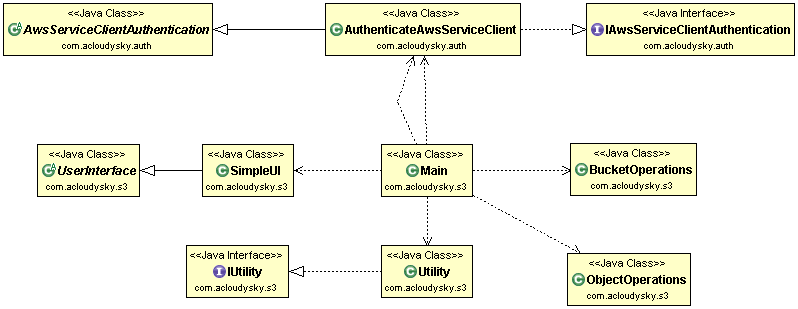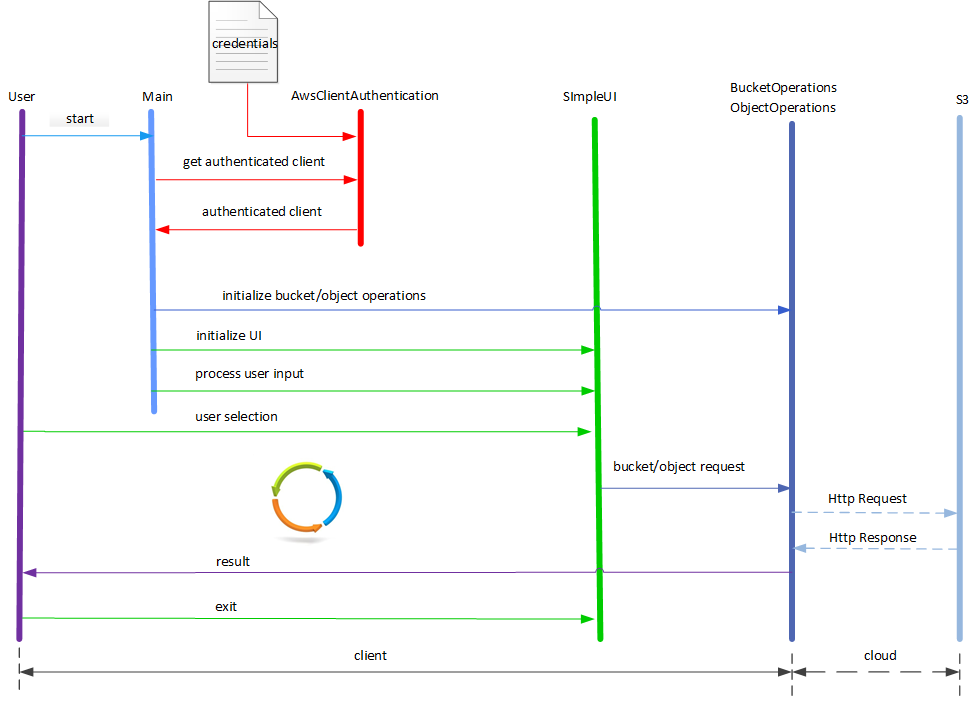This post shows how to create a Java console application to interact with Amazon S3 by using AWS Java SDK. For more information, see Using the AWS SDK for Java. A simple UI allows the user to perform tasks such as list the buckets in the account, list objects in a bucket, create a bucket, create an object and so on.
A separate project handles the creation of an S3 authenticated client which is allowed to access the EC2 service REST API.
Prerequisites

– 
– 
Application Internals
Application Class Diagram
The following is the application class diagram.

Application Workflow
The following figure shows the application event trace.

The first time the user starts the application, the Main class performs the following actions:
- Creates an authorized S3 client
- Initializes the operations classes
- Initializes the SimpleUI class
- Starts the loop to process user inputs
The SimpleUI class loops to process the user’s commands until the loop is exited. At that point, the application terminates.
Modify the pom.xml File
A key step in creating the application project is to configure the pom.xml file correctly to define the dependencies required to implement the client application. You can find the file at: pom.xml.
Application Components
This section describes the components of the application and delegates the details to the actual code implementation.
- Main. Gets authorization to access the S3 service, initializes the command classes. Delegates to the SimpleUI class the display of the selection menu and the processing of the user’s input.
- SimpleUI. Displays the menu of choices for the user. It processes the user’s input and calls the proper function based on the user’s selection. Each function calls the related AWS S3 Java library method (which in turn calls the related REST API).
- AwsClientAuthentication. Creates Amazon S3 authenticated client.
- BucketOperations. Contains methods to perform S3 Bucket operations. The following code shows how to create a bucket, for example.
123456789101112131415161718192021222324
publicstaticvoidCreateBucket(String bucketName)throwsIOException {try{System.out.println("Creating bucket "+ bucketName +"\n");// Create the bucket.s3Client.createBucket(bucketName);}catch(AmazonServiceException ase) {StringBuffer err =newStringBuffer();err.append(("Caught an AmazonServiceException, which means your request made it "+"to Amazon S3, but was rejected with an error response for some reason."));err.append(String.format("%n Error Message: %s %n", ase.getMessage()));err.append(String.format(" HTTP Status Code: %s %n", ase.getStatusCode()));err.append(String.format(" AWS Error Code: %s %n", ase.getErrorCode()));err.append(String.format(" Error Type: %s %n", ase.getErrorType()));err.append(String.format(" Request ID: %s %n", ase.getRequestId()));}catch(AmazonClientException ace) {System.out.println("Caught an AmazonClientException, which means the client encountered "+"a serious internal problem while trying to communicate with S3, "+"such as not being able to access the network.");System.out.println("Error Message: "+ ace.getMessage());}} - ObjectOperations . Contains methods to perform S3 Object operations. The following code shows how to list objects in a bucket, for example.
123456789101112131415161718192021222324252627282930313233343536373839
publicstaticvoidlistObject(String bucketName)throwsIOException {try{System.out.println("Listing objects");ListObjectsRequest listObjectsRequest =newListObjectsRequest().withBucketName(bucketName).withPrefix("m");ObjectListing objectListing;do{objectListing = s3Client.listObjects(listObjectsRequest);for(S3ObjectSummary objectSummary :objectListing.getObjectSummaries()) {System.out.println(" - "+ objectSummary.getKey() +" "+"(size = "+ objectSummary.getSize() +")");}listObjectsRequest.setMarker(objectListing.getNextMarker());}while(objectListing.isTruncated());}catch(AmazonServiceException ase) {StringBuffer err =newStringBuffer();err.append(("Caught an AmazonServiceException, which means your request made it "+"to Amazon S3, but was rejected with an error response for some reason."));err.append(String.format("%n Error Message: %s %n", ase.getMessage()));err.append(String.format(" HTTP Status Code: %s %n", ase.getStatusCode()));err.append(String.format(" AWS Error Code: %s %n", ase.getErrorCode()));err.append(String.format(" Error Type: %s %n", ase.getErrorType()));err.append(String.format(" Request ID: %s %n", ase.getRequestId()));}catch(AmazonClientException ace) {System.out.println("Caught an AmazonClientException, which means the client encountered "+"a serious internal problem while trying to communicate with S3, "+"such as not being able to access the network.");System.out.println("Error Message: "+ ace.getMessage());}}
Security Access Credentials

[default]aws_access_key_id = <your access key id>;aws_secret_access_key = <your secret key>;For information on how to create security credentials, see Create Access Credentials. See also Providing AWS Credentials in the AWS SDK for Java.
References
Getting Started with the AWS SDK for Java
Providing AWS Credentials in the AWS SDK for Java
Working with Amazon S3 Buckets
